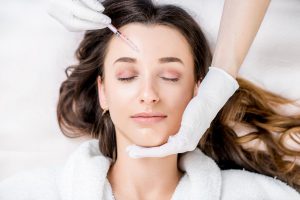Have you heard the big news?
The FDA has approved Botox Cosmetic for a third indication. The treatment of horizontal forehead lines is the newest approved application for the popular injectable, joining an indication list that already included the treatment of crow’s feet and frown lines between the eyebrows.
Botox Cosmetic (along with Dysport and Xeomin) is the most popular minimally invasive procedure for women and men, according to the most recent statistics from the American Academy of Facial Plastic and Reconstructive Surgery. Expanding its approved uses will only further this popularity, helping even more people achieve their facial aesthetic goals.
Many experienced dermatologists and plastic surgeons have been using Botox Cosmetic “off label” (outside FDA-approved use) to smooth dynamic horizontal forehead lines for years. So this approval isn’t exactly a seismic shift in the application of Botox. However it does signal the continuing growth of such injectables; and the aesthetic market in general.
Horizontal forehead creases can make us look angry, confused or just plain stressed out. Injections of Botox block the release of acetylcholine, a chemical that causes the muscle contractions that create these wrinkles.
However these injections can do more than just smooth lines if they are started early, which is sometimes called prejuvenation or more specifically, preventative Botox. In such cases, it can prevent the lines from becoming deeper.
Full results from Botox injections are visible within one week after treatment and last a minimum of three months.
Keep in mind that there are a few risks associated with Botox treatments in the forehead if overdone; namely a heavier brow and/or drooping eyelids. Other potential side effects of Botox Cosmetic injections may include headache, nausea and redness or pain at the injection site. Your doctor should go over all of the risks with you as well as share advice on how best to prevent them from occurring.
The Bigger Picture
While this nod is welcome news, the neuromodulator category of injectables lacks the type of innovation that we are seeing with another category — soft tissue fillers. There are so many different fillers available, many with different properties and benefits so that they can be uniquely matched to a wrinkle, fold or cosmetic preference.
The three available neuromodulators are all botulinum-A toxins and are very similar in terms of what they do and how they do it. That said, several companies are developing new forms of botulinum with different properties including quicker onset of action and longer lasting results and some are looking at new ways to deliver the product including topically.
We’ll continue to cover all the breakthroughs and treatment expansions as they develop. Stay tuned.


